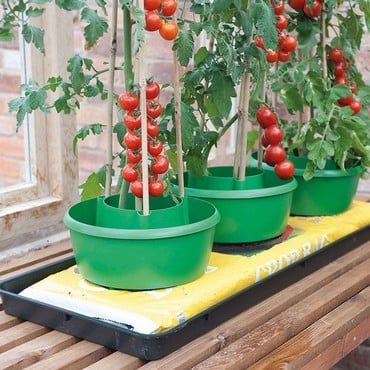Whitefly and Wasps!
This is the first year I have sought to use biological control for whitefly.
I received the packet of strips of encarsia Formosa from Harrods last Friday and hung up one striplet per growing bag or tray of tomato or pepper/aubergine plants the same day. The rest of the striplets I returned to the fridge.
I assume that the black specks in the central band are the pupae that will hatch out and attack the whitefly flakes?
By eye, it looks as if all the specks are still on the strip. (I have taken down the adhesive strips [which had been partly successful] so that the wasps will not be caught on them.)
Am I just being impatient and in due course, the wasps will “hatch” and fly off to attack the whitefly or is there something I must do to enable that to happen? If so, when, please?
Secondly, for how long will the remaining strips of encarsia still be viable? Could I apply a second treatment this coming weekend from the same packet?
Regards
Tim Pearce
Many thanks for your recent enquiry concerning the parasitic encarsia formosa wasps you have purchased to help take care of your whitefly problem. It’s encouraging to hear you have decided to give this tried and tested method of biological control a go and hopefully the information below will help...
The black ‘specks’ you see on the card are parasitised whitefly scales. These contain encarsia larvae which are feeding on the whitefly scale and will eventually leave the dead scale as an adult wasp by creating a small hole in the back; you will be able to see this exit hole through an eye lens or magnifying glass. It’s probably pertinent at this point to state that the adult encarsia wasps are tiny and bear no resemblance to common wasps.
The adult encarsia will then fly off, find a whitefly scale and lay an egg directly into the scale. The larvae will develop inside, pupate – this is when the scale turns black – and then emerge as described above. Obviously the whitefly scale is killed in the process and a reduction in numbers begins!
The encarsia really tends to look after itself but you can get an idea if things are working by checking the black scales on your cards for exit holes and also keeping an eye on whitefly scales on the plants. You should see more and more of them turn black as the wasps lay their eggs; it’s a good idea to pick a leaf, mark it and check it fairly regularly to see if the scales are changing colour. To give you an idea of timescales, most encarsia will hatch out within 2-3 days of hanging the cards in the greenhouse and you should see scales start to turn black after 2 to 3 weeks – so be patient!
Like most biological predators, encarsia formosa prefers warm, consistent temperatures and if the greenhouse remains in the region of 20°C and light levels are good (not easily done in this washout of a summer!), the predator will do the business.
I’m not sure the cards you have placed in fridge will still be viable; they are supposed to be placed in the greenhouse within 18 hours of receipt although immediately is best. If this isn’t possible, then a cool place is the next best thing but they really do need to go up within that 18 hour timeframe. You could try the refrigerated cards and see what happens!
A regular programme of cards is also the best way to go as sometimes a single application of encarsia formosa can be swamped by high numbers of whitefly and although the wasps are doing their job, the results are not evident. If whitefly numbers are or remain high, then I’d definitely consider the control programme.
Hopefully this information helps and will reassure you that nature (with a helping hand from yourself) is taking care of your greenhouse pest problem. If you’ve any further questions or queries, please don’t hesitate to ask and many thanks once again for your enquiry.
Martin

























